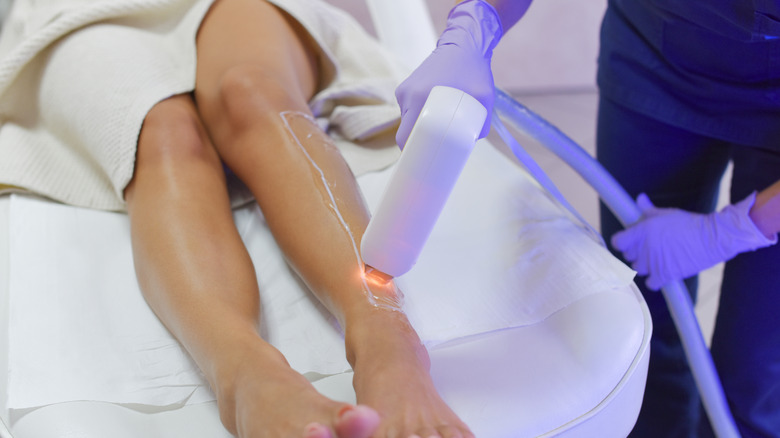Is It Possible To Achieve Permanent Hair Removal And If So, How?
A quick search of "permanent hair removal" will bring up dozens of advertisements for companies claiming their services can offer you permanently smooth, hair-free skin. But is this actually possible? And which method of hair removal is most effective, anyway?
The most popular type of "permanent" hair removal is laser hair removal, which works by using a special light to destroy hair follicles. Laser hair removal, regardless of its permanence, is a pretty popular hair removal option: In 2021, the laser hair removal industry was valued at $583.99 million, and it is expected to reach $2.51 billion by 2031. Then there's electrolysis, another popular type of long-lasting hair removal that involves inserting a tiny needle into each individual hair follicle and zapping it with electricity (um, ouch).
Though laser hair removal has been known to be a bit painful, especially on sensitive areas, some people have had a lot of success with it; one Redditor wrote that their electrolysis experience worked incredibly well and was cheaper. While she noted that it would take several sessions to achieve the desired results, she also recommended the treatment.
So, is it possible to achieve permanent hair removal, and if so, how? there are numerous different types of permanent hair removal methods, and it's up to you to choose one that suits best.
Is permanent hair removal possible?
Many hair removal methods claim to offer permanent results, but is permanent hair removal actually possible? The answer is...maybe. As frustrating as it may be, there isn't a straight answer because hair growth is highly dependent on factors like hormones and genetics, meaning one person may respond very well to hair removal interventions while another person may not.
The method of hair removal is also an important factor when thinking about permanent hair removal. Studies indicate that, for people with fair skin and dark hair, laser hair removal can be extremely effective at reducing hair growth. However, some lasers are less effective on different skin tones and hair colors. Electrolysis, another method of hair removal, is considered the most permanent type of hair removal and is the only method of hair removal that is approved by the FDA (as per Cleveland Clinic).
However, despite the FDA approval, people have varying degrees of success with electrolysis. At the end of the day, it's most accurate to say that permanent hair reduction is possible for pretty much everyone, but permanent hair removal may only be in the cards for some people.
Laser hair removal
Laser hair removal is probably the most popular type of "permanent" hair removal, and for good reason: many people experience little to no hair regrowth in the months and even years following their laser hair removal sessions.
How, exactly, does this work? According to the American Academy of Dermatology, the laser uses light, which is absorbed by the pigment in your hair. The light destroys the hair follicle, preventing it from growing back. Except it's not quite that simple. Though laser does theoretically destroy the hair follicles over time, people with hormonal imbalances may experience hair regrowth at more rapid rates than those who do not have hormonal imbalances.
This means that hair regrowth in places most affected by hormones, like the face, may require more laser sessions to see a permanent reduction. Even then, hormonal fluctuations may lead to increased hair growth over time, requiring more laser sessions to see a reduction. It's important to note the exceptions but also acknowledge that, for some people, permanent hair removal is possible with laser.
As for the pain level of laser hair removal, most people agree it is minimally painful and feels like a quick pinch; more sensitive areas may be more painful.
Electrolysis
Electrolysis is the only type of hair removal that is approved by the FDA as a "permanent" type of hair removal. Electrolysis has been used for over 100 years and is considered safe to use on most areas of the body, including the face, bikini line, underarms, fingers, and toes. Though electrolysis is FDA-approved, this doesn't guarantee permanent hair removal; it just means that electrolysis is considered the most likely to give permanent results.
If you opt for electrolysis hair removal sessions, a trained professional electrologist will insert a small wire into the skin, reaching the hair follicle. Then, a current of electricity is delivered to the hair follicle with the intent of damaging or destroying the follicle and preventing future hair growth.
Though electrolysis can be very effective, it may take more time than other methods of hair removal. This is because the electrologist must target each hair individually; depending on the area of the body being treated, it could take over a year of weekly sessions to see significant reduction or removal. Additionally, electrolysis is considered one of the more painful methods of hair removal, with many people reporting a hot pinch or prick sensation with each follicle that is treated.
IPL
You may have heard of IPL for anti-aging and other skincare concerns, but it can also be used for unwanted hair. According to facialist and laser specialist Debbie Thomas, IPL stands for "Intense Pulsed Light" and it's a method that uses light to treat issues within the skin (as per Harper's Bazaar). According to Medical News Today, IPL is pretty similar to laser in the way that it works: while laser hair removal devices use one single wavelength of light, IPL utilizes several.
When it comes to IPL for hair removal, the results seem to be mixed. Many people opt for at-home IPL devices since they're widely available, and looking at different Reddit threads, it seems like these devices work well for some and not at all for others, so some research may be required before committing to this type of hair removal. Another thing to keep in mind? Many people report that at-home IPL devices seem to hurt more than professional laser hair removal or professional IPL, so try it at your own risk!
At-home hair removal
Waxing, shaving, dermaplaning, threading, sugaring, depilatory creams, epilating: Can any of these lead to permanent hair removal? Probably not. An at-home laser hair removal device or IPL device could lead to more permanent hair reduction; one person on Reddit noted that their IPL device causes the body hair in certain parts of the body to grow thinner.
Waxing, threading, and sugaring may result in less hair or thinner hair over time, and the same goes for epilating, but these methods of hair removal may take years of repeated use to result in hair reduction. Shaving and dermaplaning are pretty much the same things, and we're pretty sure you don't need us to tell you that shaving is an impermanent hair removal solution.
As far as depilatory creams go, they work due to a chemical reaction that breaks the hair down. The main ingredient in most depilatory creams is thioglycolic acid, which is an acid that essentially dissolves the hair (as per Web MD). Though these creams can be more convenient than shaving, not to mention less painful than waxing or laser, they do not lead to permanent hair removal.
Can waxing lead to permanent hair reduction?
Although waxing is a more long-lasting form of hair removal than shaving or depilatory creams, it's still not a particularly permanent form of hair removal. If you get waxed regularly, you know you have a week or so until those pesky hairs come growing back in, making it a temporary fix.
However, waxing may lead to more hair reduction than you'd expect. This is because if you wax the same area over a long period of time, it's possible that the repeated damage to the hair follicles will lead to a permanent reduction of hair growth in that area.
According to waxing expert Diedra Green, when you wax, you pull out the hair from the root (just like epilating), so it will grow back slightly thinner each time (via Hello Giggles). Looks like there's a silver lining to the pain endured from waxing and epilating!
Prescription hair removal creams
Topical prescription creams such as Vaniqa and Eflora slow hair growth and lead to hair reduction (as per AAD). They are mostly prescribed to be used on facial hair, though there are some creams that also claim to slow hair growth on the body.
Prescription hair removal creams work by blocking an enzyme naturally found on the skin that is needed for hair growth (per Web MD). As a result, hair grows in more slowly and it can also become lighter in color and finer. Unfortunately, this is not a permanent hair removal solution; when you stop using the cream, the hair will continue growing as it did before.
Additionally, you will likely have to continue shaving, plucking, or waxing while using the cream since it is just a method of reduction and does not lead to permanent hair removal. Despite this drawback, prescription hair removal creams can be good options for people looking to make body or facial hair removal more manageable and decrease how often shaving and waxing are needed.
Hormones and hair growth
When it comes to permanent hair removal, hormones are the most important factor that will determine whether you will see permanent results. Whether you opt for laser, electrolysis, IPL, or another form of "permanent" hair reduction, your hormones can influence hair growth in such a way that these treatments do not work as effectively as intended.
People with hormonal imbalances from conditions like PCOS, certain medications, insulin resistance, and other causes may struggle with increased hair growth in unwanted areas (the face, neck, chest, or back) or find that their facial and body hair grow in darker than usual, according to Cedar Sinai.
Taking the birth control pill or gender-affirming hormones also affects hormone levels and can thereby lead to less effective hair removal treatments. While a hormonal imbalance or hormonal changes absolutely do not prevent you from trying different hair removal services, it is important to keep expectations grounded and know that you may require more hair removal sessions or that your results may not be as expected.
Factors that may impact hair removal
Hormones aren't the only factor that can impact the success of hair removal treatments: Hair color also comes into play. According to the American Academy of Dermatology, if you have white, grey, or blonde hair, laser hair removal may not work for you. Unfortunately, lasers have not proven to be effective on light-colored hair.
Until recently, many lasers were unsafe to use on dark skin since most lasers work best when there is a high contrast between skin and hair color. Although there are now several lasers that are safe to use on dark skin tones, it may be more difficult to find a laser hair removal provider that offers a laser safe for dark skin (as per Byrdie)
But that doesn't mean that those of us with light hair or darker skin tones have no hair removal options. After all, electrolysis is effective on all hair types and colors, as well as all skin colors.
Does hair removal hurt?
There are a few painless types of hair removal (shaving and depilatory creams), but most involve some level of pain. And when it comes to laser hair removal, pain seems to be part of the package.
Chloe Malle, a writer for Vogue, said her experience of laser hair removal on her legs felt like a lit match held close to her leg. Despite the fact that her dermatologist told her that each pulse from the laser would feel like the snap of a rubber band, Malle felt that the process was incredibly uncomfortable and said she had to take breaks during the session. However, Malle also noted that each session became less painful, and this is a common experience: With each appointment, fewer hair follicles are available to be zapped, resulting in less pain overall.
Electrolysis can be painful as well, but accounts vary. Smaller areas like the upper lip or eyebrows will be completed more quickly and thus be less painful; larger areas like the legs may be more difficult to get through without a numbing cream or lidocaine injection to take the edge off. In any case, most people agree that the temporary pain is worth it for long-lasting results.
How much does hair removal cost?
When it comes to the more permanent types of hair removal (laser and electrolysis), the price mostly depends on the number of sessions needed. If you were thinking you could wipe out a pesky unibrow with one session, unfortunately, this probably won't happen: Hair grows in phases, meaning multiple sessions are required to zap every hair. According to board-certified dermatologist Jessica Weiser, M.D., via Vogue, hairs have a growth face in addition to a resting and a falling-out phase. For this reason, some of the hairs in the resting phase will not respond to the treatment.
Due to this growth cycle, most people need several sessions spaced about a month apart in order to see the best results. For laser hair removal services, this can cost anywhere from $300 per treatment for a smaller area like the bikini line to $600 per treatment for a larger area like the legs. Electrolysis, on the other hand, tends to be charged per hour at rates from $50 and $125, according to Byrdie. Of course, factors like location, area of the body, and the number of sessions needed will ultimately determine the total cost for these treatments.
Important things to consider
Permanent hair removal sounds like a dream come true for those of us who are sick of constant shaving and waxing, but it's important to do your research before committing to a process like laser, electrolysis, or IPL. For example, dermatologist Dr. Weiser advises against at-home hair removal devices due to safety concerns (via Vogue). It's also very important to be very careful while using these devices as they can cause damage if overused.
You should also know the risks that come along with laser and electrolysis. Both are considered safe procedures, but both can also lead to skin irritation. Laser treatment comes with the risk of changes in skin pigmentation, blistering, scarring, and the risk for increased hair growth following laser treatment, particularly on dark skin (as per Mayo Clinic). Electrolysis can also lead to skin damage, scabbing, and scarring. Though there are risks involved, most people do not experience any adverse long-term effects with laser or electrolysis.
If you opt for laser hair removal, you may also have to make some small lifestyle changes while you're receiving treatment. For example, you can't wax while getting laser; the follicles need to present in order to be destroyed, so you can only shave unwanted hair while receiving treatment. You also have to stay out of the sun before and after laser appointments to avoid potential skin damage, as well as stay away from chemical exfoliants that can make the skin more sensitive.












